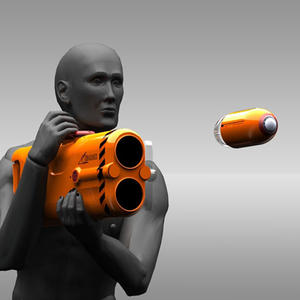Search and rescueRocket-propelled life preserver saves victims from drowning
A new rescue device ingeniously buys more time for a rescuer to ready a response and reach a drowning victim; borrowing the design of a rocket-propelled grenade, the new rescue system fires an expanding foam bullet up to 500 feet; once the bullet hits the water, it expands forty-times its original size into a life preserver; because the bullet is made of foam, even if it strikes the victim, it would do as much damage as a tennis ball

Deploying the expandable foam buoyancy projectile // Source: tuvie.com
The challenge the James Dyson Award poses for those competing to receive it is straightforward: “design something that solves a problem.”
Matthew Harwood writes that for 2010 winner of the award, Australian student and army reservist Samuel Adeloju, drowning while help is near is the problem, so he created the solution.
In a typical drowning situation, a struggling swimmer must rely on a rescuer to reach him before the water overwhelms him. Adeloju’s Longreach Buoyancy Deployment System, however, ingeniously buys more time for a rescuer to ready a response and reach the victim. Borrowing the design of a rocket-propelled grenade, Adeloju’s rescue system fires an expanding foam bullet up to 500 feet. Once the bullet hits the water, it expands forty-times its original size into a life preserver. Because the bullet is made of foam, even if it strikes the victim, it would do as much damage as a tennis ball, Adeloju told CNET Australia.
Because the system can be deployed safely from a ship deck or from shore, Longreach also minimizes the risk of a rescuer drowning during the response as well. To aid rescue during dusk and night-time, the life preserver is equipped with a light for detection.
Adeloju sees his invention in the hands of lifeguards, sailors, fishermen, and emergency personnel, really anyone who has to deal with drowning as an occupational hazard.
FastCoDesign blogger Cliff Kuang sees how valuable the Longreach would be internationally and in the United States. He notes about 4,000 Americans die every year from drowning, approximately 150 of whom fall victims to riptides.
Harwood writes that the Longreach is currently slated for field testing with Australia’s Surf Life Saving NSW, according to the Dyson description page.
For his triumph, Adeloju received a $15,000 prize for winning the 2010 James Dyson Award. The goal of the contest is “to inspire young people about design engineering.” The award’s namesake, James Dyson, an English industrial designer, is most famous for designing the bag-less vacuum cleaner.
